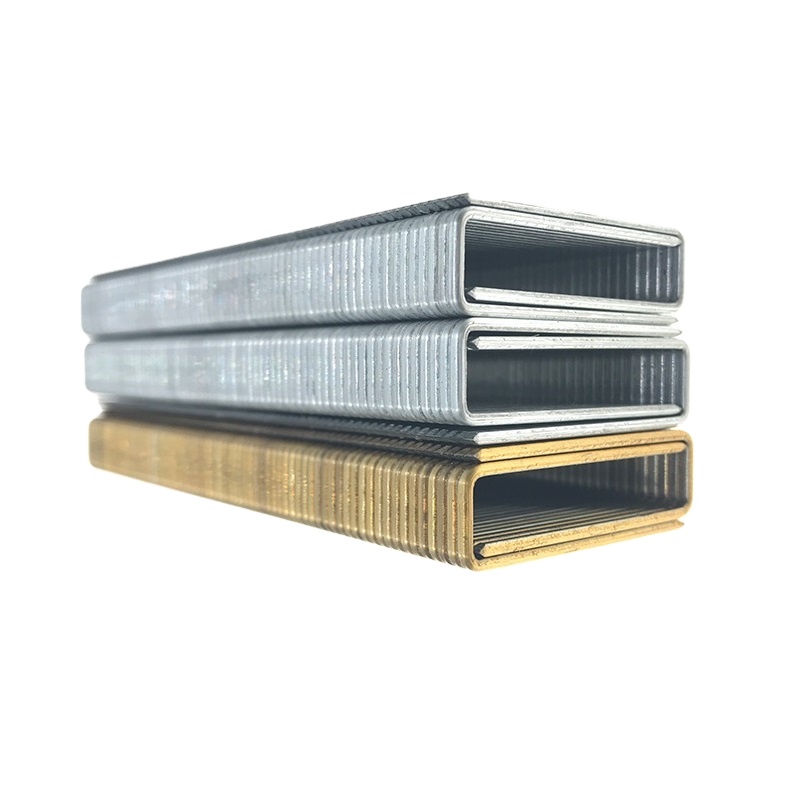Jun . 14, 2024 05:48
Back to list
Certified furniture tack nails for CE certification.
The Art of Tack Nails in CE Certification Furniture
In the realm of furniture craftsmanship, tack nails play a pivotal role, particularly when it comes to CE certification standards. These tiny fasteners are not just simple pieces of metal; they are the silent guardians of quality and safety in furniture construction. Let's delve into the intricate relationship between tack nails and CE certification in the furniture industry.
CE certification is a mandatory requirement for products sold within the European Economic Area. It serves as a mark of conformity, indicating that a product meets all applicable health, safety, and environmental protection standards. For furniture manufacturers, achieving this certification is paramount, and the use of tack nails is often a critical factor in passing these rigorous tests.
Tack nails, also known as brads, are small, sharp-pointed nails typically used to fasten light materials such as fabric, paper, or thin wood. In furniture making, they are employed for securing trim, upholstery, and other delicate elements. Their size and design allow for a clean and inconspicuous finish, which aligns with the aesthetic demands of high-quality furniture.
However, the importance of tack nails extends beyond mere aesthetics. When it comes to CE certification, these nails must adhere to specific technical requirements to ensure the furniture piece is structurally sound and safe for consumers. For instance, the nails must have sufficient holding power to prevent the materials from coming apart under normal usage conditions For instance, the nails must have sufficient holding power to prevent the materials from coming apart under normal usage conditions For instance, the nails must have sufficient holding power to prevent the materials from coming apart under normal usage conditions For instance, the nails must have sufficient holding power to prevent the materials from coming apart under normal usage conditions
For instance, the nails must have sufficient holding power to prevent the materials from coming apart under normal usage conditions For instance, the nails must have sufficient holding power to prevent the materials from coming apart under normal usage conditions ce certification furniture tack nails. They should not contain harmful substances that could leach out over time, affecting indoor air quality or posing health risks.
Manufacturers must also consider the potential hazards presented by the sharp points of tack nails. Improperly secured or protruding nails can lead to injuries, which is why many CE certified designs incorporate measures like countersinking or using washers to ensure the nail heads are flush with the surface or otherwise protected.
Moreover, the application process of tack nails requires precision. The right tool, such as a pneumatic nail gun, ensures consistent depth and angle of penetration, reducing the risk of splitting the wood or damaging the upholstery. Quality control checks during production are vital to guarantee that each nail is set correctly and contributes to the overall integrity of the furniture piece.
In conclusion, while tack nails may seem like a minor detail in furniture manufacturing, their correct selection and application are crucial for achieving CE certification. They represent a microcosm of the dedication to excellence and safety that underpins the furniture industry's commitment to meeting European standards. As we appreciate the fine craftsmanship in our homes, let us not forget the unsung heroes like the humble tack nail, without which, the beauty and security we enjoy would not be possible.
ce certification furniture tack nails. They should not contain harmful substances that could leach out over time, affecting indoor air quality or posing health risks.
Manufacturers must also consider the potential hazards presented by the sharp points of tack nails. Improperly secured or protruding nails can lead to injuries, which is why many CE certified designs incorporate measures like countersinking or using washers to ensure the nail heads are flush with the surface or otherwise protected.
Moreover, the application process of tack nails requires precision. The right tool, such as a pneumatic nail gun, ensures consistent depth and angle of penetration, reducing the risk of splitting the wood or damaging the upholstery. Quality control checks during production are vital to guarantee that each nail is set correctly and contributes to the overall integrity of the furniture piece.
In conclusion, while tack nails may seem like a minor detail in furniture manufacturing, their correct selection and application are crucial for achieving CE certification. They represent a microcosm of the dedication to excellence and safety that underpins the furniture industry's commitment to meeting European standards. As we appreciate the fine craftsmanship in our homes, let us not forget the unsung heroes like the humble tack nail, without which, the beauty and security we enjoy would not be possible.
 For instance, the nails must have sufficient holding power to prevent the materials from coming apart under normal usage conditions For instance, the nails must have sufficient holding power to prevent the materials from coming apart under normal usage conditions
For instance, the nails must have sufficient holding power to prevent the materials from coming apart under normal usage conditions For instance, the nails must have sufficient holding power to prevent the materials from coming apart under normal usage conditions ce certification furniture tack nails. They should not contain harmful substances that could leach out over time, affecting indoor air quality or posing health risks.
Manufacturers must also consider the potential hazards presented by the sharp points of tack nails. Improperly secured or protruding nails can lead to injuries, which is why many CE certified designs incorporate measures like countersinking or using washers to ensure the nail heads are flush with the surface or otherwise protected.
Moreover, the application process of tack nails requires precision. The right tool, such as a pneumatic nail gun, ensures consistent depth and angle of penetration, reducing the risk of splitting the wood or damaging the upholstery. Quality control checks during production are vital to guarantee that each nail is set correctly and contributes to the overall integrity of the furniture piece.
In conclusion, while tack nails may seem like a minor detail in furniture manufacturing, their correct selection and application are crucial for achieving CE certification. They represent a microcosm of the dedication to excellence and safety that underpins the furniture industry's commitment to meeting European standards. As we appreciate the fine craftsmanship in our homes, let us not forget the unsung heroes like the humble tack nail, without which, the beauty and security we enjoy would not be possible.
ce certification furniture tack nails. They should not contain harmful substances that could leach out over time, affecting indoor air quality or posing health risks.
Manufacturers must also consider the potential hazards presented by the sharp points of tack nails. Improperly secured or protruding nails can lead to injuries, which is why many CE certified designs incorporate measures like countersinking or using washers to ensure the nail heads are flush with the surface or otherwise protected.
Moreover, the application process of tack nails requires precision. The right tool, such as a pneumatic nail gun, ensures consistent depth and angle of penetration, reducing the risk of splitting the wood or damaging the upholstery. Quality control checks during production are vital to guarantee that each nail is set correctly and contributes to the overall integrity of the furniture piece.
In conclusion, while tack nails may seem like a minor detail in furniture manufacturing, their correct selection and application are crucial for achieving CE certification. They represent a microcosm of the dedication to excellence and safety that underpins the furniture industry's commitment to meeting European standards. As we appreciate the fine craftsmanship in our homes, let us not forget the unsung heroes like the humble tack nail, without which, the beauty and security we enjoy would not be possible. Latest news
-
Manufacturer producing brad nails for staple guns with high quality and durability.NewsJul.16,2024
-
CE certification for 5-8mm brad nails and its importance in construction.NewsJul.16,2024
-
Top 16 Gauge Brad Nail Manufacturers with High Quality Products and ServicesNewsJul.16,2024
-
China 18 Gauge Brad Nails for Precision Carpentry Projects in 2021.NewsJul.16,2024
-
Top manufacturer of BN1810 brad nails, providing high quality products for various applications.NewsJul.16,2024
-
Get the job done with 18-gauge staples in 40mm size for various projects.NewsJul.15,2024
